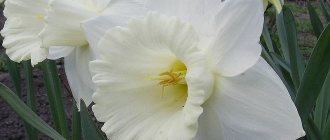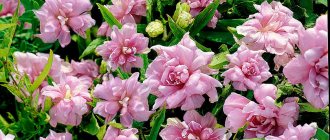The herbaceous annual and perennial plant chrysanthemum (Chrysanthemum) is a member of the Asteraceae family. From Greek, the name of the plant is translated as “sun flower” or “golden flower”; the fact is that in most species the inflorescences are yellow. According to the GRIN website, this genus unites approximately 29 species that are naturally found in the temperate and northern zones, and most often in Asia. Archaeologists are confident that the ancient Chinese grew chrysanthemums more than 2.5 thousand years ago; they ate the petals of this plant. The chrysanthemum was also mentioned by Confucius himself in the treatise “Spring and Autumn”. Later, the Japanese began to grow the plant, who idolized the chrysanthemum so much that only members of the imperial family had the right to wear clothes with its image. The flower appeared in Europe only in the 18th century, but it became popular among gardeners only in the 19th century. Today, the garden chrysanthemum (Chrysanthemum hortorum) is the most popular among gardeners; scientists believe that it was formed as a result of crossing two Asian species: the large-flowered chrysanthemum (Chrysanthemum morifoolium), which is native to China, and the small-flowered chrysanthemum (Chrysanthemum indicum) from Japan . However, some experts believe that the garden chrysanthemum appeared due to the crossing of the Chinese chrysanthemum and the small-flowered Indian chrysanthemum. There are a huge number of chrysanthemum varieties, and breeders are still working on developing new unusual varieties.
Description of the plant
Chrysanthemum is a long-blooming symbol of emperors. The great thing about chrysanthemums is that they bloom until late autumn. Their noble charm was appreciated by residents of the Far East, where these plants are found in nature. Most chrysanthemums come from Korea, China, and Japan.
They came to Europe 300 years ago, but only gained popularity during Art Nouveau times, thanks to the fashion for this type of flower, when they became a characteristic motif of the pattern. They decorated ceramics, porcelain, paintings, and textiles.
This is interesting! The stylized chrysanthemum is part of the coat of arms of the Emperor of Japan, and in China it was forbidden to export their seedlings for centuries. The flower was associated with nobility and immortality.
Chrysanthemums (Chrysanthemum) are a very large group of plants that perfectly decorate flower beds. We also know them as stunning cut flowers that can be purchased from any florist. These are plants of the Asteraceae family.
The word chrysanthemum comes from the word chrysos, which means gold. This group includes plants:
- greenhouse grown (Indian);
- ground (Arctic, Indian, Korean).
Their height, depending on the species, is very diverse, ranging from 25 to 250 cm. The stems of the plants are usually hard, covered with thin hairs. The leaves are dark green, pinnate or toothed, up to 15 cm long.
When choosing chrysanthemums for growing in the garden, you should know that this group includes annual and perennial plants.
Garden chrysanthemums come in different colors: white, red, brown, pink, yellow. Chrysanthemum flowers are divided into:
- simple - the flower basket consists of ligulate marginal flowers located in one row, the middle of the inflorescence is filled with yellow tubular flowers;
- semi-double – characterized by a convex center of the flower;
- terry - belong to the most diverse group, the marginal flowers are arranged in multi-rows, forming double spherical inflorescences in the form of pompoms.
The inflorescences are divided into needle-shaped, dahlia-like, aster-like, and spherical chrysanthemums; their cultivation and care differ slightly. These are mainly hybrids, that is, varieties of chrysanthemum obtained as a result of complex crossings.
Neighborhood in a flowerbed with other flowers
Depending on the chosen variety, chrysanthemums bloom at the beginning of summer, in the middle, or at the beginning of autumn, and continue until the first severe frost. They begin to bloom in mid-summer. Chrysanthemums look very beautiful in mixboards with asters, sedum, rudbeckia, echinacea, and ornamental cereals. They are also planted against the backdrop of evergreen ornamental shrubs.
Types and varieties
There are many classifications of chrysanthemums.
In the fall, especially in November, a lot of beautiful varieties of chrysanthemums appear on sale with:
- large flowers formed one on each shoot;
- small flowers, numerous on branched shoots.
These beautiful specimens are treated as seasonal plants and are propagated by qualified gardeners.
Worth knowing! Chrysanthemums are short-day flowers. This feature causes most of them to bloom so late. Of course, in specialized greenhouse growing facilities, gardeners can regulate lighting and temperature, so we can admire chrysanthemums at any time of the year.
Chrysanthemums will certainly decorate your apartment with expressive flowers. Low-growing varieties of chrysanthemums from the greenhouse group are suitable for growing as cut flowers. It should be remembered that the plant needs to be dug up after flowering. Most of the beautiful chrysanthemums are not capable of overwintering in the soil due to sensitivity to negative temperatures.
Some chrysanthemums can be grown in open ground all year round. An example is the Korean chrysanthemum (Chrysanthemum × coreaum). Chrysanthemum × coreaum blooms in late autumn. This more frost-resistant variety comes in numerous colors:
- "Apollo" is a beautiful variety with orange-red flowers;
- “Hebe” – with a pure pink color;
- 'Nancy Copland' is an expressive variety with cherry blossoms.
They can reach several tens of centimeters in height, but are usually taller. To make bush chrysanthemums bloom abundantly, the tops should be removed in early summer. This procedure will ensure stronger tillering and, therefore, more flowers. The species has several uses - it works well in gardens, in groups, and rockeries.
Arctic chrysanthemum (Chrysanthemum arcticum) is suitable for decorating rocky gardens. The plant is characterized by a creeping form and reaches 30 cm in height. The Arctic variety blooms from September to October with white flower petals and a greenish center.
Perennial chrysanthemums are plants belonging to the genus Dendranthema. Among them are common:
- varieties for ridges (frost-resistant or partially frost-resistant varieties suitable for growing in open ground);
- potted plants;
- varieties grown for cut flowers (most of them require cultivation in greenhouses).
You can read more in the article - Varieties of chrysanthemums.
Due to their suitability for growing in the garden, in unprotected soil, in the remainder of the article we will focus on perennial chrysanthemums.
Caring for garden chrysanthemum
Even an amateur gardener can grow a chrysanthemum in his garden, but in order for the bushes to be as lush, beautiful and disease-free as possible, you need to know a few tricks. For example, after seedlings planted in open soil have taken root well, become stronger and have formed their eighth true leaf plate, they are pinched to make the bushes more lush. Soon side shoots should appear on the plant, when this happens, they are also pinched, as a result, your area will be decorated with spectacular dense bushes, and when flowers appear on them, they will look like fluffy balls.
When growing large-flowered varieties, you need to pay attention to the fact that it is recommended to remove all side shoots, leaving only a few of the most powerful ones. Cut shoots can be used as cuttings; they give roots very quickly. Some vigorous varieties require support; for this, you can install a net, metal pegs or a wire structure near the bush. It will support the bush and prevent it from falling apart.
Watering
The crop must be watered regularly and abundantly; if the plants do not have enough moisture, then their shoots will become woody and the inflorescences will not be so beautiful. The bushes should be watered with rain or well-settled water (it can be mixed with 2 drops of ammonia). Water is poured under the root, try not to get it on the surface of the leaf plates. After watering, the surface of the earth around the bushes is loosened, and all weeds are removed. In order to make caring for the plant easier, immediately after planting the seedlings, cover the surface of the area with a layer of mulch.
Fertilizer
In order for the bushes to grow and develop normally, they are systematically fed. During the growing season, flowers are fed at least 3 times; for this, organic matter and mineral fertilizers are alternately used. At the beginning of the growing season, the bushes need nitrogen; ammonia nitrogen is best suited for this; thanks to this feeding, the bushes will quickly increase their green mass. To stimulate lush flowering, chrysanthemums are fed with potassium-phosphorus fertilizer during the formation of buds.
For feeding, liquid nutrient solutions are used; they are poured at the root of the bushes the next day after watering or rain. The plants are fed for the first time in the first 1.5–2 months after they are planted in open ground. From organic matter, you can use burnt mullein or bird droppings. Experienced gardeners say that it is better not to feed the chrysanthemum rather than to burn it.
Chrysanthemum multiflora, feeding during flowering.
Transfer
A flower can be grown in the same place for no longer than 3 years, otherwise it will begin to “be capricious”, namely: the inflorescences will begin to shred, and it will also get sick much more often. In this regard, in spring it is necessary to remove an adult bush (over three years old) from the ground and replant it.
As a rule, this procedure is carried out in conjunction with dividing the bush, so that the plant can be propagated. To do this, carefully remove it from the soil, while trying not to injure the root system, and shake off the soil from it. Divide the bush into several sections, each of which should have shoots and roots; for this you can use pruners or a very sharp knife. After this, the divisions are planted in a well-lit area in the same way as seedlings (see above).
Landing
To grow chrysanthemums in flower beds, you need to choose a sunny place. The most suitable position is well protected from the cold.
Soil selection
Some varieties have a very poorly developed root system. On the other hand, they may have a highly developed aerial part. Because of this imbalance, special soils are required.
The soil must be permeable. Chrysanthemums prefer fertile, humus, nutritious soils rich in minerals. Heavy soils increase the likelihood of plants freezing. The optimal pH for this plant ranges from 6.5-7; under these conditions, nutrients are absorbed better and faster. Substrates that include peat or a mixture of peat and sand (90% peat, 10% sand) work well.
Purchase and storage of seedlings
It is better to plant purchased seedlings in late spring, when the risk of frost has passed.
Seedlings can be stored for a short time in good conditions. In a cold room at 4-5 °C and a relative humidity of 80-90% they can be stored for several days, but not longer than a week. Long-term storage, even at low temperatures, leads to the growth and “stretching” of seedlings. This negatively affects the development of seedlings and can affect the entry of plants into the generative phase (flowering) under short-day conditions even at the stage of growing seedlings.
Landing
The planting site should be prepared in the fall of the previous year by enriching the soil with compost or well-spread manure. A manure substitute can be manure granules, amophoska or vermicompost.
The distance between plants should be 30-40 centimeters. One seedling is planted in a pot, placing it in the center and deepening it well. Some gardeners plant chrysanthemums in this way: they pour the substrate only half or ¾ of the height of the pot; when the plant grows above the pot, it rests on the edges of the pot and does not break.
Immediately after planting, the plants are watered, then the watering is stopped for about a week (but without allowing the substrate to dry out too much - the weather must be taken into account). This method should ensure good rooting of seedlings buried deep in the substrate and ensure good stability of the planted plants.
When growing a plant in open ground for cut flowers, the plant density per square meter should be 48-64, or even 80 plants (for small varieties).
Small-flowered varieties are planted from late April to late June.
During the first week, you need to take care of the good survival of the plants, provide good conditions - if necessary, spray, shade, protect from drafts. In the first week after planting, chrysanthemums can be fed with fertilizer with a high phosphorus content. The use of biostimulating agents can also have a good effect at this stage.
Main problems when growing
During the growing season of plants in apartment conditions, gardeners are faced with various problems; let’s consider the main ones.
Why do the leaves turn yellow?
If replanting after purchase was not accompanied by proper care of the crop, yellowing of the leaves of the flower can be observed.
This unpleasant phenomenon is associated with a lack of lighting, lack of moisture in the nutrient substrate or hot air in the room .
Sometimes the cause of leaf discoloration can be a fungal infection.
To prevent drying out, you need to take into account all these nuances.
Why doesn't chrysanthemum bloom?
The lack of flowering on a crop in most cases occurs due to a deficiency or excess of natural light.
It should be taken into account that chrysanthemum is considered a short-day crop. When lighting devices are turned on in the morning and evening, the biorhythms of the flower are disrupted. Another reason why chrysanthemum does not bloom is excessive feeding.
Growing and care
Chrysanthemums are relatively easy to grow. In order for plants to be beautiful and healthy, we must provide them with optimal conditions for development. When growing chrysanthemums, much depends on the quality of the material used for planting, planting technique and proper agricultural practices at the beginning of cultivation. Every 3-4 years, plants should be replanted to a new location. After flowering, the above-ground part should be cut to a height of about 10 cm.
Weed the flower bed regularly and water during drought. Some varieties start blooming as early as August and stay in bloom until November, so the effort will pay off.
It is important to remove weeds on time.
Breaking off shoots, supports
About 2 weeks after planting, it is worth trimming the tops of the shoots (cut off about 1.5 cm). This will ensure better tillering of the plants. To prevent the stems from falling sideways under the weight of the flowers (there is such a tendency), the tips are broken off when they reach 10-15 cm. This will force the plant to grow. For summer varieties, it is enough to break off the tip once, for autumn varieties – 2-3 times.
The treatment is carried out on the young, non-lignified part of the shoot, above the 5-8 leaf.
Tall plants require support.
Watering
In our climatic conditions, watering has a significant impact on the growth vigor and general condition of plants. Due to the fact that chrysanthemums require regular watering, the ideal solution is to install a drip irrigation line. Plants react negatively to overdrying, which manifests itself in the rapid withering of entire bushes.
It is important to prevent excessive root flooding. Watering too much can lead to rotting and fungal diseases. If leaves are frequently wetted, plants are at risk of rust infection.
Feeding
Chrysanthemums, due to their “gluttony” during the growth period, require systematic fertilizer, up to 2 times a month.
Chrysanthemum seedlings planted in the spring will require additional feeding during the development of flower buds. They are then fed every 2 weeks with diluted liquid fertilizer. Immediately before the buds open, fertilizing should be stopped. If you continue to feed chrysanthemums, their shoots may become too wild and lethargic. This will worsen the appearance of garden chrysanthemums and increase the risk of disease. If the soil is properly prepared in the fall, it will have enough nutrients to support proper plant growth.
Plant shading
Chrysanthemums are short-day plants; they set and develop flower buds when the day is short - 8-12 hours. On longer days, flower buds are delayed or do not appear at all, and plants grow vegetatively (large increase in heavily leafy shoots). Artificially shortening the day through the use of shading mats allows flowering to occur at any time.
Autumn care and wintering of chrysanthemums
Some chrysanthemums can overwinter in unprotected soil in flower beds. To do this, you need to choose frost-resistant varieties. Frost resistance is demonstrated by varieties of reddish chrysanthemum (Chrysanthemum rubellum). The previously mentioned Indian chrysanthemum Clara curtis will also cope with frost.
In autumn, when the first frosts destroy the inflorescences, cut the chrysanthemum stems at a height of about 15 cm above the soil surface. Pruning reduces the risk of plant rotting and fungal diseases.
Attention! Chrysanthemums do not tolerate excessive humidity very well. Therefore, to protect them from frost, choose a ventilated shelter, for example, spruce branches. Under no circumstances cover cut shoots of chrysanthemums with leaves or compost for the winter.
If the soil in the flowerbed is very wet, it is better to dig up the rhizome and move it for the winter to a cold, clean room, protected from frost - a greenhouse, an unheated greenhouse.
Chrysanthemums grown in pots require moving to frost-protected areas. Potted chrysanthemums left on terraces and balconies are doomed to freeze.
Growing chrysanthemums from seeds
Sowing in the ground
The easiest way to propagate chrysanthemums is by dividing the bush and cuttings. However, very often, a chrysanthemum grown from a seed becomes the pride of a gardener. Seeds are used to propagate both annuals and perennials, for example, Korean chrysanthemum. Below we will talk about growing such a flower from seeds using annuals as an example.
In May, after the return frosts are left behind, planting holes must be made on the site, the distance between which should be from 20 to 25 centimeters. They are spilled with lukewarm water and 2 or 3 seeds are placed in them. When the holes are filled with soil, you need to cover them on top with garden film, thereby you will be able to retain the moisture and heat necessary for seed germination in the soil. After the first seedlings appear, the cover is removed, and the surface of the soil in the area is carefully loosened, removing all the weeds. A week and a half after the emergence of seedlings, fertilizing is carried out with a very weak concentration of “Rainbow” or “Ideal” solution.
After the seedlings reach a height of 70 to 100 mm, they are thinned out. As a result, in each hole there should remain one of the strongest plants with 3 or 4 true leaf blades formed. If desired, excess seedlings can be transplanted to another location. Annual chrysanthemums grown from seeds will begin to bloom in August. In order for the bushes to please with early flowering, they are grown through seedlings.
Sowing seedlings
To grow seedlings, you will need low boxes filled with a substrate that includes humus, greenhouse soil and peat (1:1:1). The soil mixture can be bought at a specialized store, where it has already been disinfested and disinfected. The substrate prepared by yourself must be sifted and calcined at a temperature of 110 to 130 degrees. At the bottom of the box, first make a good drainage layer from expanded clay or pieces of brick. It is covered with prepared substrate, and seed material is evenly distributed on its surface. When sowing perennial seeds, they are not poured on top, but only lightly pressed into the soil mixture. And when sowing annuals, the seed material is sprinkled on top with a half-centimeter layer of substrate. Water the crops with a sprayer with lukewarm water and cover the container with film (glass) on top. Place the crops in a warm place (from 23 to 25 degrees), ventilate them systematically and moisten the substrate with a spray bottle, preventing it from drying out. If everything is done correctly, the first seedlings should appear 10–15 days after sowing. As soon as this happens, the box is moved to a well-lit place. The shelter is not removed immediately, but gradually, so that the plant has time to get used to the new conditions. To begin with, the shelter is removed for 1 hour, then for a couple of hours, and so on, until the plants get used to the new growth conditions.
If excessively dense seedlings appear after they have grown, they are planted in individual cups with the same substrate that is used for sowing seeds. This is done after the plants have formed from 2 to 4 true leaf blades; during transplantation, try not to injure their root system. Before starting picking, water the soil mixture in the box generously. During transplantation, discard plants that are too weak and elongated. In order for the seedlings to take root faster, after transplanting they are moistened from a sprayer with a solution of Epin or Zircon.
About sowing in detail!!! We grow chrysanthemums from seeds.
Seedling care
After picking, the seedlings are removed to a cool (16 to 18 degrees) and well-lit place. Watering is carried out only when necessary, and fertilizing is carried out regularly once every 2 weeks, for this purpose a solution of complex mineral fertilizer is used. If necessary, illuminate the seedlings with fluorescent lamps. Remember that seedlings of such a crop are characterized by extremely slow growth, so after 6 weeks their height reaches only about 20 centimeters.
Chrysanthemum propagation
Chrysanthemums are propagated by cuttings and dividing the bush. Some varieties can be propagated by seeds and even collected seeds, which then repeat the features of the mother plant, for example, dendranthema grandiflora.
Propagation by cuttings
Chrysanthemum stems cut in the fall will produce new shoots from their side buds in the spring. Shoots growing from the rhizome at the base of the main shoot can be cut into cuttings. This is done in early spring.
Stages of work:
- Cuttings are cut to a length of 5-6 cm.
- The lower end of the cuttings (about 1 cm) should be immersed in the rooting agent.
- The cuttings are planted in a pot filled with a mixture of peat and sand (1:1 ratio).
- Cuttings should be watered regularly and protected from drying out and temperature drops below 15 °C. The optimal temperature for cuttings is 16-18 degrees Celsius. Such conditions are provided in greenhouses.
Chrysanthemum cuttings should take root after 3 weeks. Then you can begin hardening (getting used to external conditions by frequently ventilating the greenhouse). You can transplant seedlings into unprotected soil at the end of spring, when the danger of frost has passed. In June, chrysanthemum seedlings should be planted in the ground.
Dividing the bush
Different types of chrysanthemums are divided at different times:
- blooming in late autumn, divided in spring;
- Blooming in summer, divide immediately after flowering.
The division should be done every few years. Having dug up the plant, it is carefully divided into parts with a sharp tool. If necessary, roots that are too long and overgrown can be trimmed a little.
Delenki should be planted in fertile, humus soil. In soils that are too light, sandy, chrysanthemums are more likely to freeze. They are also susceptible to overdrying.
From seeds
Chrysanthemums can be propagated by seeds. Dendranthema grandiflora or Siberian, Korean small-flowered and annual varieties are propagated from seeds. Seeds of annual varieties are sown in the ground in mid-late May, when warm weather sets in and the soil warms up to 14-15 degrees. Experienced gardeners sow chrysanthemums at the same time as cucumbers. These are heat-loving plants. Seeds germinate approximately 2 weeks after planting.
Where and how to plant?
To grow chrysanthemums, you need an elevated sunny location and well-drained, slightly acidic or neutral soil. With insufficient lighting, the shoots become elongated and thinner, and flowering occurs late.
Chrysanthemums love well-fertilized soils. In such soil they bloom luxuriantly. If the soil in the garden is infertile and dense, before planting the cuttings we fertilize it with rotted manure, compost, peat, as well as the addition of complex mineral fertilizer.
It is better to plant chrysanthemum cuttings not in holes, but in a trench at a distance of 30-50 cm. This depends on the characteristics of the variety: lush and tall bushes are planted further from each other, and small ones - closer to each other.
After planting, we spill the soil in the trench with a root solution (1 g per 1 liter of water). This promotes the formation of a powerful root system in the cuttings. This means that a strong and beautiful plant will develop from a young twig!
We protect the seedlings from above with a light covering material. It creates a favorable microclimate for them: it protects young chrysanthemums from hot rays and warms them during cold periods.
Diseases and pests
Sometimes chrysanthemums are attacked by diseases or pests. You need to be vigilant to start the fight as soon as possible.
Powdery mildew
This is a very common disease among many plants and appears as a white powdery coating. In case of disease, spray the appropriate antifungal agent (for example, Topaz), heavily infected parts of the chrysanthemum are removed. Treatment should be repeated 3 times.
Rust
In addition to powdery mildew, it is worth mentioning rust, which manifests itself in rusty spots on the leaves. It is worth choosing varieties with greater resistance to rust.
White rust chrysanthemums
The disease is caused by the fungus Puccinia horiana. Often appears in greenhouses due to high humidity. The fungus affects leaves and other above-ground parts of plants. White or light green, round spots appear on the upper side of the leaves. The spots can be single or multiple, sometimes merging into one spot, covering the entire leaf. On the back of the leaf, a cluster of spores in the form of white pillows is visible.
Severely affected leaves become deformed, dry out, do not fall, and hang on the plant. The fungus develops at temperatures from 0 ° C to 30 ° C (the optimal temperature for its development is 17-21 ° C) and relative air humidity above 96%. At lower humidity, spores in the air die within minutes. The first symptoms from the moment of infection appear after 5-6 days, so you can buy seedlings that look healthy, but are already infected with fungi.
The pathogen overwinters on infected plants, often on those that do not show signs of rust. The fungus remains viable on plant debris for up to 8 weeks.
It is important to carry out prevention:
- do not plant flowers too densely;
- water in the morning, do not spray the leaves (do not leave the plants wet at night);
- preventively spray flowers with fungicides after planting;
- spray with special preparations as soon as possible after detecting the first symptoms of the disease;
- burn vegetable waste (do not compost).
Septoria leaf blight
The causative agent is Septoria chrysanthemella. The most common fungal disease of chrysanthemum. The first symptoms, in the form of dark brown, mostly round spots, appear on the oldest leaves. In humid conditions and rainy weather, the disease quickly spreads to young leaves. Severely infected leaves are brown, dry and die prematurely. Plants become weaker, flowers become smaller.
Protection options are root watering, crop rotation, preventative spraying of plants at 10-day intervals with approved medications, especially in rainy weather.
Sclerotinia sclerotiiformes
Symptoms of the disease most often appear during storage in the form of thick, fluffy white mycelium covering the roots of the plant. In the white mycelium, a black sclerotia of the fungus is visible, the size of a grain of wheat. The disease causes the greatest losses during storage. The disease is introduced through infected roots or leaf debris. The first symptoms of infection may appear on the petioles or at the base of leaves, visible as dark brown, watery spots.
Verticillium wilt
The fungus causes the death of leaves in the lower parts of the plant. It is necessary to carry out treatments with antifungal drugs in a timely manner and avoid dampness in the flowerbed.
Bacterial rot
Another serious disease affecting these beautiful flowers. Infected bushes have soft stems, and after an initial yellowing the plant turns brown and dies. This is a rapidly spreading disease that occurs primarily in the fall. Occurs due to excessive soil moisture. To prevent the development of this disease, remove infected shoots and increase the potassium content in the soil.
Gray mold
High humidity, often due to overly dense plantings, can lead to gray mold. The disease leads to the death of flower buds. Infected plants should be discarded to prevent the spread of the disease.
Viral diseases
These diseases cause changes in the appearance of the plant (changes in color, size and appearance of flowers and leaves). Unfortunately, they are not curable, you can only prevent them. To do this, you need to remove infected plants and disinfect the tools with which they are grown.
Pests
Pests that can harm chrysanthemums include:
- Chrysanthemum nematode. Symptoms of damage are the appearance of brown spots and drying out of plants. The appearance of nematodes is prevented by applying special protective measures to the soil.
- The plant is sometimes attacked by spider mites, western thrips, cutworms, snails, broomrape fly, and aphids. If they appear, use an appropriate insecticide.
Aphids are a very dangerous pest; as a result of their feeding, the plant is deformed, growth and flowering are inhibited. If a colony of aphids appears, you need to act immediately.
Care after flowering
This applies to those types of chrysanthemums that will remain outside in the winter. To make it easier for them to endure the winter, you need to feed them for the last time in September, and when the first frosts occur, it is recommended to trim the chrysanthemums so that only small shoots, about 10-15 cm in height, remain on the surface.
Ideally, additionally insulate the rhizomes of plants with fallen leaves. If your region has harsh winters, it is additionally recommended to add spruce branches or brushwood to the foliage.
It is not recommended to cover chrysanthemums with film or other materials that do not allow air to pass through, because in this case the plant will rot a lot, and subsequently get sick, or even die.
Application in landscape design
These are plants with very versatile uses, with different varieties enjoying growing popularity.
Chrysanthemums can be used as follows:
- in garden beds;
- in containers on terraces, balconies;
- like cut flowers for vases.
Chrysanthemums will help maintain the elegant, decorative appearance of a flower bed until winter comes. On an autumn morning, when the first frosts have passed, flowering plants, the petals of which are covered with ice crystals or drops of dew showering the flowers, will add a special charm to the garden.
How to choose the right seedlings?
When purchasing seedlings, pay attention not only to the overall healthy appearance of the plant, but also to the quantity and quality of buds. The buds should already begin to open and show the tips of the flower petals. Then your chrysanthemum will definitely bloom after planting in the ground! If the plant is purchased with green buds, the flowers may not open.
What can I do to make chrysanthemums last longer in a vase?
Chrysanthemums are one of the most durable cut flowers. Their shelf life can be up to 4 weeks. Thanks to appropriate care procedures (mainly light control), cut chrysanthemums are available throughout the year.
- do not buy chrysanthemums whose flowers are weakly held, dangling, and whose leaves do not have an intense color (this means that they dry out);
- shorten the ends of the stems by about 2 centimeters;
- it is necessary to shorten the stems at an angle - thanks to this we unblock the conducting vessels located in the stem so that the plant can take water;
- fill the vase with fresh, clean water;
- change the water in the vase every day, each time you will have to shorten the stem by about 1 centimeter;
- It’s good to add conditioner for cut flowers to the water - in this case you don’t need to change the water every day, just add fresh water;
- Instead of conditioner, you can add aspirin to the water - it extends the freshness of cut flowers.
General information
The word “chrysanthemum” comes from the Greek language and means “golden flower” or “golden flower”. This is not in vain, because most species have yellow inflorescences.
The fact that this is an unusual and quite valuable flower is evidenced by at least the mention of it by Confucius in his treatise “Spring and Autumn”. The Japanese depicted this plant on the clothes of the imperial family, and no one else had the right to wear things with such a design.
The genus of chrysanthemums has 29 species, most often scattered in the temperate and northern zones. The most popular types are garden, large-flowered and small-flowered chrysanthemums.
According to experts, the most desirable among gardeners is precisely the result of crossing Chinese and small-flowered Indian species. Breeders continue to pay great attention to these plants and are trying to develop more and more new varieties.
Earlier we talked about chrysanthemum multiflora.
This representative of garden flora is valued for its intense color rendition at the end of the growing season. Modern cultivated varieties are much more interesting than their wild relatives.
- Plants come in chamomile-shaped, spherical, and pompon-shaped. Colors range from pure white to gold, bronze, pink and lavender, coral and salmon, purple and burgundy red.
- Chrysanthemum flowers consist of many individual flowers that can produce seeds. By the way, individual flowers from a common “basket” are ligulate marginal and central tubular.
- They are arranged in one row, with the exception of hybrid types of chrysanthemums, in which the flowers are arranged in multiple rows, creating a very lush inflorescence.
It is important to know that chrysanthemums can be either subshrubs or simply herbaceous plants. Down appears on the stems of some species.
The leaves of chrysanthemums are also different; they are united only by green, sometimes dark green color. The shape of the leaf blade is serrated, notched or dissected.
Pros and cons of chrysanthemum
Advantages and disadvantages
Incredibly beautiful appearance.
Frost resistance.
Excellent fittings.
Unpretentiousness.
Easy to care for.
Susceptible to many diseases, including incurable ones.
Demanding on conditions and planting location.
Now that you know everything about chrysanthemums, you can draw some conclusions. Chrysanthemum is a fairly simple plant in terms of care, and even novice gardeners can grow it. The only caveat is to choose varieties that are resistant to our winters, and also regularly prune and choose the right place for planting. Then your chrysanthemums will be magnificent.
Recommendations from gardeners
After planting, caring for chrysanthemums is actually quite simple. It consists in:
- regular watering;
- periodic loosening of the soil;
- weeding;
- periodic spraying with pest control solutions.
Chrysanthemums tolerate cold quite well, but still they also require insulation. Around the end of October, flower beds should be protected from the first frosts using a frame with plastic film stretched over it. Thanks to this shelter, you will be able to watch the beautiful blooming chrysanthemums that you planted in the spring for at least another month. True, at the end of autumn the frame will still have to be removed, and the flowers transplanted into pots and sent to a warm veranda until April.
In general, as you can see, growing chrysanthemums in the garden is not so difficult. To do this you will need a minimum of knowledge, time and effort. And if you are no longer a beginner in gardening, then you can easily cope with this plant. If you previously had an indoor flower bride, caring for a chrysanthemum will not be difficult for you. After all, these plants are very similar to each other. The only difference is that the bride grows in a pot, and the chrysanthemum loves open ground.
How to control pests
As you already know, moisture-loving chrysanthemums simply adore watering and cannot do without it, especially during dry seasons. And regular irrigation prevents the occurrence of mites and aphids that do not tolerate water.
But still, watering alone is not enough to eliminate all kinds of pests. After all, many pathogens and pathogens live in the soil. So after rains, plants should be treated with special preventive solutions, the most popular of which are Previkur and Quadris.
Thanks to “Fitosporin” you can protect your chrysanthemums from root rot. This product just needs to be added to the water before each feeding.
Chrysanthemums in the garden are threatened by all kinds of street dwellers and diseases.
- Spider mite. An insect that sucks sap from plants. You can find it on the web on the back of the leaves. If the leaves of a flower turn gray-brown, begin to darken and fall off, most likely they are being hunted by spider mites. In this case, the plant should be treated with special chemicals, such as “Aktellika”, “Iskra.” or "Rabitora".
- Leaf nematodes. These pests can be identified by painful deformations of the leaves and darkening of the veins. In such a situation, gardeners recommend changing the soil and cutting off damaged areas.
- Verticillium. An infectious disease that penetrates a plant through the root system. With this disease, the first thing that happens is the leaves located below begin to turn yellow and wither. If you identify the problem in time, spraying with special preparations, such as Fitoverma and Aktara, will help solve the problem.
- Powdery mildew. First it affects the buds and leaves, on which a strange white coating appears, and then gets to the roots. In this case, you should cut off the damaged areas and treat the plant with Bordeaux mixture.
- Caterpillars. They are considered the most dangerous garden inhabitants for plants. Only one caterpillar can eat several buds per night. That is why it is so important to regularly inspect the flowers, eliminating various pests.
How to preserve chrysanthemums in winter
Heat-loving large-flowered varieties are afraid of frost and do not disappear in winter. Such varieties are usually dug out of the ground before frost (by selecting the mother bushes), placed in wooden boxes and stored in a cool room with a temperature of 2-6 degrees until spring.
Chrysanthemums are watered occasionally to keep the lump of earth moist.











